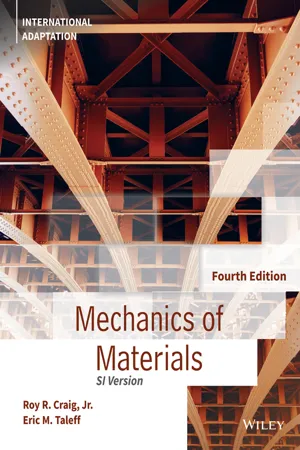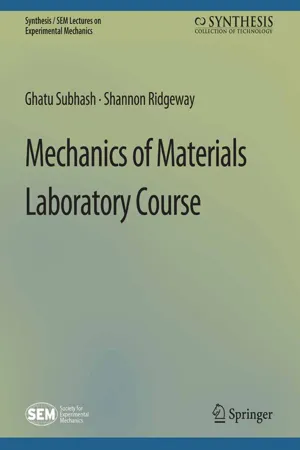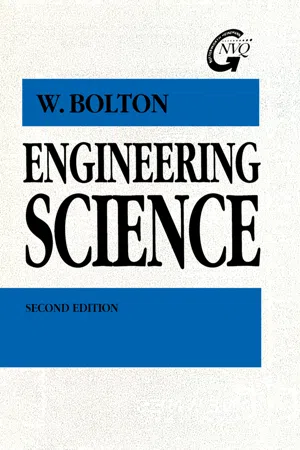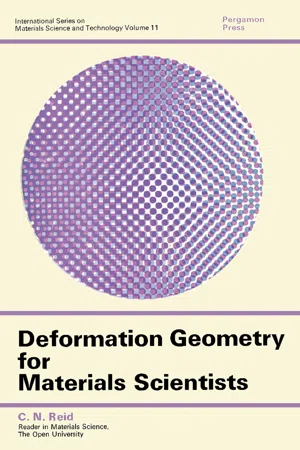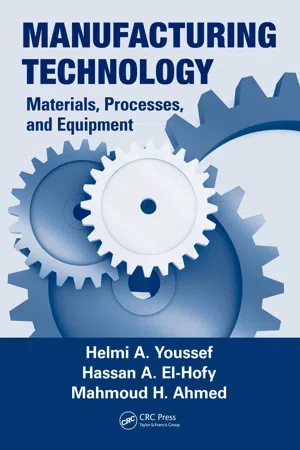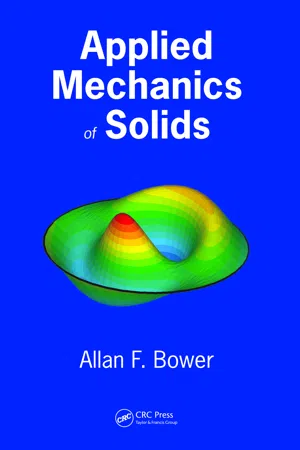Technology & Engineering
True Stress and Strain
True stress and strain are measures used in materials engineering to account for the change in cross-sectional area and length of a material as it undergoes deformation. True stress takes into consideration the actual cross-sectional area at any given point during deformation, while true strain accounts for the actual change in length of the material. These measures provide a more accurate representation of a material's behavior under load.
Written by Perlego with AI-assistance
Related key terms
1 of 5
11 Key excerpts on "True Stress and Strain"
- eBook - PDF
- William F. Riley, Leroy D. Sturges, Don H. Morris(Authors)
- 2018(Publication Date)
- Wiley(Publisher)
(Courtesy of MTS Systems Corporation.) 4-2 STRESS-STRAIN DIAGRAMS 155 dividing the load by the initial cross-sectional area of the specimen. The area will change somewhat during the loading, and the stress obtained using the initial area is obviously not the exact stress occurring at higher loads. However, it is the stress most commonly used in designing structures. Stress obtained by dividing the load by the actual area is frequently called the true stress and is useful in explaining the fundamental behavior of materials. 4-2-2 Strain Measurement Strains are small in materials used in engi- neering structures, often less than 0.001, and their accurate determination requires special measuring equipment. Normal strain is obtained by measuring the de- formation δ in a length L and dividing δ by L. Instruments for measuring the deformation δ are called strain gages or extensometers and obtain the desired accuracy by multiplying levers, dial indicators, beams of light, or other means. The electrical resistance strain gage is widely used for this type of measure- ment. True strain, like true stress, is computed on the basis of the actual length of the test specimen during the test and is used primarily to study the funda- mental properties of materials. The difference between nominal stress and strain, computed from initial dimensions of the specimen, and True Stress and Strain is negligible for stresses usually encountered in engineering structures, but some- times the difference becomes important with larger stresses and strains. A more complete discussion of the experimental determination of stress and strain will be found in various books on experimental stress analysis. 1 4-2-3 Example Stress-Strain Diagrams Figures 4-3a, b, and c show tensile stress-strain diagrams for structural steel (a low-carbon steel), for a magnesium alloy, and for a gray cast iron, respectively. - Roy R. Craig, Jr., Eric M. Taleff(Authors)
- 2023(Publication Date)
- Wiley(Publisher)
True stress and true strain are given by the formulas σ true min true ln = = + P A , ( ) 1 (2.13) True strain can also be expressed in terms of area change 12 true min ln = A A 0 The solid-line curve in Fig. 2.11a is a conventional stress-strain diagram of engi- neering stress versus engineering strain, while the dashed curve is a sketch of true stress versus true strain. The curves differ only when strain is large and when the cross-sectional area is decreasing significantly. Figures 2.11a and 2.11b both illustrate the stress-strain behavior of struc- tural steel. Materials scientists and metallurgists have developed a number of processes for altering the mechanical properties of metals, including alloying, work-hardening, and tempering. Figure 2.13 contrasts the tensile stress-strain behavior of several ferrous metals. Stress-strain curves for several aluminum alloys are shown in Fig. 2.14. 13 Figure 2.12 A hot-rolled steel tensile specimen. (Courtesy Roy Craig.) ( a) ( b) Figure 2.13 The stress-strain curves of plain carbon steel and three high-strength/low-alloy steels. (Used with the permission of ASM International.) plain carbon steel 690 552 414 276 138 Stress – MPa 0 0 10 20 30 40 Strain – percent SAE 950X SAE 980X GM 980X 12 This formula for true strain is given by D. C. Drucker in Introduction to Mechanics of Deformable Solids [Ref. 2-2], p. 12. 13 ASM International, www.asminternational.org, is an excellent source for information on the mechanical properties of materials. ASM publishes the Atlas of Stress-Strain Curves, the Metals Handbook, the Engineered Materials Handbook, and many other reference works. 46 Chapter 2 Stress and Strain It is apparent from a comparison of Figs. 2.11 and 2.14 that several properties exhibited by structural steel, for example, a definite yield point followed by a significant zone of yielding at constant stress, are not characteristic of all other materials.- Wole Soboyejo(Author)
- 2002(Publication Date)
- CRC Press(Publisher)
3 ________________________ Basic Definitions of Stress and Strain 3.1 INTRODUCTION The mechanical properties of materials describe their characteristic responses to applied loads and displacements. However, most texts relate the mechanical properties of materials to stresses and strains. It is, therefore, important for the reader to become familiar with the basic definitions of stress and strain before proceeding on to the remaining chapters of this book. However, the well-prepared reader may choose to skip/skim this chapter, and then move on to Chap. 4 in which the fundamentals of elas-ticity are introduced. The basic definitions of stress and strain are presented in this chapter along with experimental methods for the measurement and application of strain and stress. The chapter starts with the relationships between applied loads/displacements and geometry that give rise to the basic definitions of strain and stress. Simple experimental methods for the measurement of strain and stress are then presented before describing the test machines that are often used for the application of strain and stress in the laboratory. 3.2 BASIC DEFINITIONS OF STRESS The forces applied to the surface of a body may be resolved into compo-nents that are perpendicular or parallel to the surface, Figs 3.1(a)-3.1(c). In 59 (a) 60 (b) Chapter 3 Simple tension,- eBook - PDF
- Ghatu Subhash, Shannon Ridgeway, Ghatu Zimmerman(Authors)
- 2022(Publication Date)
- Springer(Publisher)
87 L A B O R A T O R Y 3 Stress–Strain Response of Materials 88 3. STRESS–STRAIN RESPONSE OF MATERIALS PART A: THEORY 3.1 INTRODUCTION Structural components in engineering applications are subjected to complex loads and under- standing the influence of these loads is crucial to their safe design. However, because of the complexity of operating environment, we try to understand the material behavior in simplified loading conditions and then formulate failure theories for deformation behavior under complex combination of loads. To this end, we focus on material deformation under simple uniaxial (1D) tension and compression. Let us review two fundamental concepts in mechanics of materials. (i) Stress: Intensity of internal force at a given point. The intensity is measured as, internal force (P ) divided by area (A) at that location. Note that P is not the external applied force. The internal force is the resultant of all the applied external forces (and moments) acting at that point on a given cross sectional plane. To obtain resultant internal force, a cut section is made at that point and the forces are vectorially summed. For simple uniaxial loading along x-axis on a bar, the stress acting on a plane perpendicular to the loading axis is given by x D P =A (3.1) (ii) Strain: Change in length (dl )/original length (l ). If the change in length is in axial direc- tion x, then " x D dl=l (3.2) In both of the above equations, the denominators A and l refer to either original dimen- sions or current dimensions. If original dimensions are used, then they are called “engineering stress” and “engineering strain,” and if current dimensions are used, they are referred to as “true stress” and “true strain.” To conduct tension test (see Fig. 3.1), we typically use a dog bone-shaped specimen, grip it on two ends, and pull on it. The gage section is assumed to undergo uniform and uniaxial deformation and this deformation (elongation) is measured using an extensometer. - eBook - PDF
- William Bolton(Author)
- 2016(Publication Date)
- Newnes(Publisher)
The area used in the calculation of the stress is generally the original area that existed before the stress occurred. This stress is sometimes referred to as the engineering stress. The true stress would be the force divided by the actual area existing in the stressed state. Example 1 A bar of material with a cross-sectional area of 50 mm 2 was subjected to tensile forces of 0.1 kN. What was the stress induced in the bar? From above, force 0.1 stress = = —— area 50 = 0.002 kN/mm 2 = 0.002 GN/m 2 = 2 MN/m 2 = 2 MPa stress force area Stress and strain 97 Example 2 A pipe has an outside diameter of 50 mm and an inside diameter of 45 mm and is acted on by a tensile force of 50 kN. What is the stress acting on the pipe? First, cross-sectional area = (D 2 -d 2 ) 4 where D is the external diameter and d the internal diameter. Thus cross-sectional area = f(50 2 - 45 2 ) = 373 mm 2 Hence stress = ^ 9 ^ = Mi = 0.134 kN/mm 2 = 0.134 GPa = 134 MPa area 373 Strain The change in shape of a body resulting from stress is described by strain. For materials subject to tension or compression (for shear strain see later this chapter), change in length strain = — original length Because strain is a ratio of two lengths it has no units. It is frequently expressed as a percentage. Example 3 A tensile test specimen has a gauge length of 50 mm. This increases by 0.030 mm when subject to tensile forces. What is the strain? From above * · change in length 0.030 Λ Λ ^ Λ Λ , ~ strain = — . ? f .— °r-= —=jr- = 0.0006 = 0.06% original length 50 T h e tensile test The tensile test involves the stretching of a test piece of material and the monitoring of the forces used and the resulting extensions of a gauge length. Figure 6.1 shows a graph of stress against strain which is typical of that produced when a tensile test is carried out on carbon steel. - eBook - PDF
Deformation Geometry for Materials Scientists
International Series on Materials Science and Technology
- C. N. Reid, W. S. Owen(Authors)
- 2016(Publication Date)
- Pergamon(Publisher)
After these changes of axes, the state of stress is represented by 0 i.e. the sum of a hydrostatic stress and three pure shear stresses. The right-hand term contains the so-called deviatone stresses. P 0 0] 0 p 0 .0 0 p + Γ 0 V(-hs) W(-iqs) K=-r,0) *-Normal stress |(0, δχ < i After deformation I ' V V» > δχ iSu < Figure 1.12 A diagram of simple stretching. We seek a quantity that represents the deformation irrespective of the points considered, and we call this the strain in the body. - eBook - PDF
Strength of Materials & Structures N5
TVET FIRST
- P du Toit, A Knott(Authors)
- 2022(Publication Date)
- Macmillan(Publisher)
Module TVET FIRST 1 Stress, strain and tensile testing of materials 1 Stress, strain and tensile testing of materials Overview of Module 1 When you have completed this module, you should be able to: Unit 1.1: Stress and strain and tensile testing of materials • Name the three different types of stresses. • Calculate direct and shear stresses. • Know what strain is and how to calculate it. • Know what modulus of elasticity is and how to calculate it. • Calculate the change in length, final length and percentage change in length of the bar. • Draw a stress/strain graph and use it to obtain information about a material. • Draw a force/extension graph or stress/strain graph and use it to calculate Young’s modulus for a material. Unit 1.2: Compound bars • Calculate stresses for different materials connected in parallel, including a pipe with threaded bar and nut. • Calculate stresses when different materials are connected in series. • Calculate change in length of each material. • Calculate the final length of a compound bar. Some of the most important aspects of any engineering design are the material, type of loading, size and shape of a part. Engineers must consider all these aspects when designing parts. When a system of forces acts on a material, the material is put under stress and strain, as shown in Figure 1.1. Stress is the deformation force per unit area of the body or material. Strain is the deformation that a part undergoes due to an external force. When two or more bars made of different materials are combined and work together to resist a force, they form a compound bar. The way these bars react to forces acting on them depends on whether they are joined in parallel or in series. - Available until 4 Dec |Learn more
Manufacturing Technology
Materials, Processes, and Equipment
- Helmi A. Youssef, Hassan A. El-Hofy, Mahmoud H. Ahmed(Authors)
- 2011(Publication Date)
- CRC Press(Publisher)
the.load.in.the.plastic.range.as.the.specimen.elongates,.then.the.instantaneous.area.should.be.used. to.represent.the.true.stress.in.the.plastic.deformation.range . .Then,.the.true.stress.is.expressed.as, . True stress / / i o o eng o eng σ σ σ = = = = = P A P A P A A A l l ( ) 1 + ε eng . (8 .5) where. A i .is.the.instantaneous.area,.which.is.commonly.referred.to.as. A .without.suffix . Similarly,.due.to.the.large.elongations.in.the.plastic.range,.the.true.strain.is.the.sum.of.increments. of.strains,.and.thus.if.the.length.increases.from. L 0 .to.the.instantaneous.length. L i .through.increments. L 1 ,. L 2 ,. . . . . . .,.then.the.true.strain.is.calculated.as . ε = -+ -+ = = = = ∑ L L L L L L L L L L i i i i 0 1 0 1 2 1 0 0 0 … Δ ln . (8 .6) Then, . ε ε true eng = + = + ( ) ln ln L L L 0 0 1 Δ . (8 .7) Being.expressed.in.terms.of.the.natural.logarithm.of.the.instantaneous.length.to.the.initial.length. ratio,. the. true. strain. is. commonly. known. as. the. natural. strain,. or. logarithmic. strain . . The. true. stresses.and.true.strains.are.almost.the.same.as.the.engineering.stresses.and.engineering.strains.in. the.elastic.range,.but.deviations.increase.with.the.increase.of.the.plastic.strain,.as.shown.in.Figure. 8.3a. .Therefore,.in.plastic.deformation.calculations,.true.stresses.and.true.strains.should.be.used . Example 1 A bar of length L o is elongated to a final length of 1.5 L o , and then compressed again to its original length L o . Calculate the engineering and true strains in both cases, and comment on the results. When the bar is elongated ε ε eng o o o true o o = -= = = 1 5 0 5 1 5 0 41 . . ln . . L L L L L Fundamentals of Metal Forming 179 When the bar is compressed from 1.5 L o to L o ε ε eng o o o true o o = -= -= = -L L L L L 1 5 1 5 0 33 1 5 . - eBook - PDF
- W. C. Bolton(Author)
- 2013(Publication Date)
- Wiley-Blackwell(Publisher)
Chapter 2 Simple stress and strain 2.1 Stress and strain When a body is subject to external forces, internal forces are set up in it which oppose the external forces. We can consider a body to be like a spring, which if stretched by external forces sets up internal forces which resist the pull extending it. The simplest case of loading is that of a straight metal bar of constant cross-section which has external forces applied at its ends along the bar axis and which either stretch the bar or compress it, as in figure 2.1. The bar is then said to be in tension or compression. If we consider a plane in the bar which is at right angles to its axis, the internal forces are at right angles to the plane. The term direct stress is used for the value of this force per unit area of the plane. Fig. 2.1 Bar in tension. Direct stress σ = force area [1] With the force in N and the area in m 2 then the stress is in N/m 2 . The name pascal (Pa) is used for 1 N/m 2 . It is important to realise that the above equation gives the average direct stress acting on the sectional area since it is assumed that the same force acts over the entire area. With concentrated loads or where the material being loaded has changes in shape, e.g. a hole through a bar, then the stress will not generally be the same over each segment of cross-sectional area. The maximum stress will depend on the bar’s geometry and the type of discontinuity. Tables and graphs are available which enable a stress concen-tration factor K to be determined, the maximum stress then being K times the average stress. In general, when a body is subject to loading, the internal forces may be resolved into components which are at right angles to and parallel to a plane within the body. The right angle components give tensile or compressive 25 26 Mechanical Science forces and direct stresses , the parallel component being termed a shear force and giving shear stresses . - eBook - PDF
- William F. Hosford(Author)
- 2009(Publication Date)
- Cambridge University Press(Publisher)
In contrast, if there has been extensive plastic deformation preceding fracture, the material is con-sidered ductile . Fracture usually occurs as soon as a critical stress has been reached; however, repeated applications of a somewhat lower stress may cause fracture. This is called fatigue . The amount of deformation that a material undergoes is described by strain. The forces acting on a body are described by stress. Although the reader should already be familiar with these terms, they will be reviewed in this chapter. 1 2 Mechanical Behavior of Materials Stress Stress , σ , is defined as the intensity of force at a point. σ = ∂ F /∂ A as ∂ A → 0 . (1.1a) If the state of stress is the same everywhere in a body, σ = F / A . (1.1b) A normal stress (compressive or tensile) is one in which the force is normal to the area on which it acts. With a shear stress, the force is parallel to the area on which it acts. Two subscripts are required to define a stress. The first subscript denotes the normal to the plane on which the force acts, and the second subscript identifies the direction of the force. ∗ For example, a tensile stress in the x-direction is denoted by σ xx indicating that the force is in the x-direction and it acts on a plane normal to x. For a shear stress, σ xy , a force in the y-direction acts on a plane normal to x. Because stresses involve both forces and areas, they are not vector quantities. Nine components of stress are needed to fully describe a state of stress at a point, as shown in Figure 1.1 . The stress component, σ yy = F y / A y , describes the tensile stress in the y-direction. The stress component, σ zy = F y / A z , is the shear stress caused by a shear force in the y-direction acting on a plane normal to z. Repeated subscripts denote normal stresses (e.g., σ xx , σ yy ), whereas mixed sub-scripts denote shear stresses (e.g., σ xy , σ zx ). - eBook - PDF
- Allan F. Bower(Author)
- 2009(Publication Date)
- CRC Press(Publisher)
It must therefore be a function of the deformation gradient or a strain measure that is derived from it. If we accept the preceding assumptions, it means that we can measure the relationship between stress and strain by doing an experiment that induces a uniform strain in a suit-able sample of the material. According to our assumptions, the stress should also be uni-form and can be calculated from the forces acting on the specimen. These are clearly approximations. Materials are not really uniform at small scales, whether you choose to look at the atomic scale or the microstructural scale. However, these features are usually much smaller than the solid part or component, and the material can be regarded as statistically uniform, in the sense that, if you cut two specimens with similar size out of the material, they will behave in the same way. A continuum model then describes the average stress and deformation in a region of the material that is larger than microstructural features but small compared with the dimensions of the part. 3.1 GENERAL REQUIREMENTS FOR CONSTITUTIVE EQUATIONS You may be called on to develop a stress-strain law for a new material at some point in your career. If so, it is essential to make sure that the stress-strain law satisfies two conditions: 1. It must obey the laws of thermodynamics. 2. It must satisfy the condition of objectivity or material frame indifference. In addition, it is a good idea to ensure that the material satisfies the Drucker stability criterion discussed in more detail below. Of course, your proposed law must conform to experimental measurements and, if possible, should be based on some understanding of the physical processes that govern the response of the solid. 3.1.1 Thermodynamic Restrictions The laws of thermodynamics impose two restrictions on stress-strain laws: 1.
Index pages curate the most relevant extracts from our library of academic textbooks. They’ve been created using an in-house natural language model (NLM), each adding context and meaning to key research topics.

